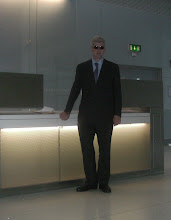 But in scramjets, so-called because they are 'supersonic combustion ramjets', airflow throughout the engine remains supersonic - using the oxygen in the incoming air to ignite hydrogen fuel. The expanding hot gases from combustion accelerate the exhaust air to create tremendous thrust. The engines could slash satellite launch costs, because there is no need for liquid oxygen as fuel. The U.S. space shuttle has to carry more than a million pounds of liquid oxygen each time it lifts off.
But in scramjets, so-called because they are 'supersonic combustion ramjets', airflow throughout the engine remains supersonic - using the oxygen in the incoming air to ignite hydrogen fuel. The expanding hot gases from combustion accelerate the exhaust air to create tremendous thrust. The engines could slash satellite launch costs, because there is no need for liquid oxygen as fuel. The U.S. space shuttle has to carry more than a million pounds of liquid oxygen each time it lifts off.
The experimental scramjet travelled at Mach 6 for almost three minutes
The U.S Air Force said the previous record for a hypersonic scramjet burn was 12 seconds.’ We are ecstatic to have accomplished many of the X-51A test points during its first hypersonic mission,’ said Charlie Brink, an X-51A program manager with the Air Force Research Laboratory.’ We equate this leap in engine technology as equivalent to the post-World War II jump from propeller-driven aircraft to jet engines,’ Mr. Brink said. A passenger plane traveling at Mach 6 would cut the flight time from London to Sydney to little more than two hours’ Andrew Coates, of the Millard Space Science Lab at University College London, said the effects for passengers aboard a scramjet-powered plane would be 'more akin to space travel than airline travel’. They would need protective clothing to counteract the effects of the G-forces pressing on the body during acceleration to 5,000mph.British scientists have worked on designs for scramjets but do not expect one to be available for commercial flights until at least 2020.Professor John Fielding, Head of Aerospace at Cranfield University said that the prohibitive cost of scramjets would be a 'major issue' before any commercial design could be developed.



No comments:
Post a Comment